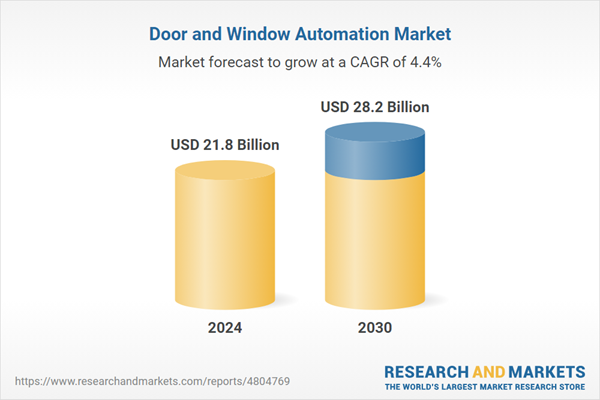The global market for Door and Window Automation was valued at US$21.8 Billion in 2024 and is projected to reach US$28.2 Billion by 2030, growing at a CAGR of 4.4% from 2024 to 2030. This comprehensive report provides an in-depth analysis of market trends, drivers, and forecasts, helping you make informed business decisions.
Global Door and Window Automation Market - Key Trends and Drivers Summarized
What Is Door and Window Automation and How Is It Transforming Modern Architecture?
Door and window automation refers to the use of advanced technology to control the opening, closing, and locking of doors and windows in residential, commercial, and industrial buildings. This technology integrates sensors, motors, and control systems to automate functions that were traditionally manual, enhancing convenience, security, and energy efficiency. Automated doors and windows are particularly valuable in settings where accessibility, safety, and efficiency are paramount, such as in hospitals, airports, and high-traffic public spaces. The technology has also made significant inroads into residential applications, where smart home systems are increasingly incorporating automated doors and windows for improved living comfort and security. The integration of automation into building design is reshaping modern architecture by enabling smarter, more responsive environments that cater to the evolving needs of occupants.How Does Door and Window Automation Improve Building Efficiency and Safety?
The adoption of door and window automation significantly enhances building efficiency and safety by offering precise control over access and ventilation. Automated systems can be programmed to respond to various environmental factors, such as temperature, humidity, and occupancy, optimizing indoor conditions without the need for manual intervention. For instance, automated windows can be configured to open during cooler parts of the day to allow natural ventilation, reducing the need for air conditioning and lowering energy consumption. In terms of safety, automated doors equipped with sensors can prevent accidents by ensuring that doors do not close when someone is in the way. Additionally, these systems can be integrated with security systems to automatically lock or unlock doors based on preset schedules or in response to specific events, such as fire alarms or unauthorized access attempts. This level of automation not only improves the safety and security of buildings but also contributes to operational efficiency by minimizing human error and reducing the need for manual monitoring.The Expanding Applications of Door and Window Automation Across Various Sectors
The applications of door and window automation are expanding rapidly across a variety of sectors, driven by the need for enhanced functionality, security, and energy efficiency. In commercial and public buildings, automated doors are becoming standard in entryways, providing seamless access for all users, including those with disabilities. In the healthcare sector, automated doors and windows are essential in maintaining sterile environments, controlling air flow, and ensuring the privacy and safety of patients. The retail industry also benefits from automated systems, which help manage foot traffic, secure premises after hours, and enhance customer experiences through convenience. In residential buildings, smart home systems that include automated doors and windows are becoming increasingly popular, offering homeowners remote control over their environment through smartphones or voice commands. The growing trend of integrating automation into architectural design reflects the increasing demand for buildings that are not only intelligent and adaptable but also capable of enhancing the quality of life for their occupants.What Drives the Growth in the Door and Window Automation Market?
The growth in the door and window automation market is driven by several factors, including the increasing demand for smart buildings, the emphasis on energy efficiency, and the growing awareness of safety and accessibility needs. As the concept of smart cities gains traction, the integration of automated systems into building design is becoming more common, with developers and architects seeking to create environments that are responsive to the needs of their users. Energy efficiency is another key driver, as automated doors and windows play a crucial role in reducing energy consumption by optimizing natural ventilation and insulation. The push for sustainability in construction is further propelling the adoption of automation technologies. Additionally, the growing emphasis on accessibility and safety in public and private spaces is fueling demand for automated systems that cater to people with disabilities and enhance overall building security. Advances in technology, such as the development of more affordable and reliable automation systems, are also contributing to the market's expansion, making these solutions more accessible to a broader range of consumers and businesses. As these trends continue, the door and window automation market is expected to see sustained growth, driven by the ongoing pursuit of smarter, more efficient, and safer building environments.Report Scope
The report analyzes the Door and Window Automation market, presented in terms of market value (US$ Thousand). The analysis covers the key segments and geographic regions outlined below.Segments
Product (Pedestrian Doors, Automated Windows, Industrial Doors); End-Use (Commercial Buildings, Industrial Buildings, Hotels & Restaurants, Other End-Uses).Geographic Regions/Countries
World; United States; Canada; Japan; China; Europe (France; Germany; Italy; United Kingdom; and Rest of Europe); Asia-Pacific; Rest of World.Key Insights:
- Market Growth: Understand the significant growth trajectory of the Pedestrian Doors segment, which is expected to reach US$13.9 Billion by 2030 with a CAGR of a 4.2%. The Automated Windows segment is also set to grow at 5.0% CAGR over the analysis period.
- Regional Analysis: Gain insights into the U.S. market, valued at $5.8 Billion in 2024, and China, forecasted to grow at an impressive 4.2% CAGR to reach $4.5 Billion by 2030. Discover growth trends in other key regions, including Japan, Canada, Germany, and the Asia-Pacific.
Report Features:
- Comprehensive Market Data: Independent analysis of annual sales and market forecasts in US$ Million from 2024 to 2030.
- In-Depth Regional Analysis: Detailed insights into key markets, including the U.S., China, Japan, Canada, Europe, Asia-Pacific, Latin America, Middle East, and Africa.
- Company Profiles: Coverage of major players such as ABB Group, Allegion PLC, Assa Abloy AB, Came S.P.A., Dormakaba International Holding AG and more.
- Complimentary Updates: Receive free report updates for one year to keep you informed of the latest market developments.
Why You Should Buy This Report:
- Detailed Market Analysis: Access a thorough analysis of the Global Door and Window Automation Market, covering all major geographic regions and market segments.
- Competitive Insights: Get an overview of the competitive landscape, including the market presence of major players across different geographies.
- Future Trends and Drivers: Understand the key trends and drivers shaping the future of the Global Door and Window Automation Market.
- Actionable Insights: Benefit from actionable insights that can help you identify new revenue opportunities and make strategic business decisions.
Key Questions Answered:
- How is the Global Door and Window Automation Market expected to evolve by 2030?
- What are the main drivers and restraints affecting the market?
- Which market segments will grow the most over the forecast period?
- How will market shares for different regions and segments change by 2030?
- Who are the leading players in the market, and what are their prospects?
Some of the 36 major companies featured in this Door and Window Automation market report include:
- ABB Group
- Allegion PLC
- Assa Abloy AB
- Came S.P.A.
- Dormakaba International Holding AG
- GEZE GmbH
- Gira Giersiepen GmbH & Co. KG
- Honeywell International, Inc.
- INSTEON
- Nabtesco Corporation
- Royal Boon Edam International B.V. (Boon Edam)
- Schneider Electric SE
- Siemens AG
- Stanley Black & Decker, Inc.
Table of Contents
I. METHODOLOGYII. EXECUTIVE SUMMARY2. FOCUS ON SELECT PLAYERSIII. MARKET ANALYSISIV. COMPETITION
1. MARKET OVERVIEW
3. MARKET TRENDS & DRIVERS
4. GLOBAL MARKET PERSPECTIVE
UNITED STATES
CANADA
JAPAN
CHINA
EUROPE
FRANCE
GERMANY
ITALY
UNITED KINGDOM
REST OF EUROPE
ASIA-PACIFIC
REST OF WORLD
Companies Mentioned
- ABB Group
- Allegion PLC
- Assa Abloy AB
- Came S.P.A.
- Dormakaba International Holding AG
- GEZE GmbH
- Gira Giersiepen GmbH & Co. KG
- Honeywell International, Inc.
- INSTEON
- Nabtesco Corporation
- Royal Boon Edam International B.V. (Boon Edam)
- Schneider Electric SE
- Siemens AG
- Stanley Black & Decker, Inc.
Table Information
| Report Attribute | Details |
|---|---|
| No. of Pages | 191 |
| Published | February 2025 |
| Forecast Period | 2024 - 2030 |
| Estimated Market Value ( USD | $ 21.8 Billion |
| Forecasted Market Value ( USD | $ 28.2 Billion |
| Compound Annual Growth Rate | 4.4% |
| Regions Covered | Global |
| No. of Companies Mentioned | 14 |









